Labradors shed a lot, especially at when the seasons change. But dealing with your Labrador shedding is not as bad as you might think, if you have the right tools, a good method and a solid routine in place. No shaving with clippers or haircuts with scissors will be needed!
I quickly brush my Labs once a week with a slicker or pin brush, and then give them a thorough grooming with a deshedding tool a few times a year when they blow their coats. It’s a spectacular event, and leaves a huge pile of groomed off fluff that I leave out for the birds to use in their nests!
- Why do Labradors shed so much?
- Do some colors shed more than others?
- Grooming your dog
- Keeping your home fur free
All Retrievers shed – at times profusely. If you let the hair build up, either on your dog or in your home, it can be quite overwhelming. Coping with Labrador shedding is much easier if you adopt a daily grooming and vacuuming routine. Getting the right tools to help you can really make a difference.
Why Dogs Shed
Many wild animals, especially those that live in parts of the world with very different seasons, have a twice yearly ‘moult’. Usually in spring and again as winter approaches. During the spring moult, the animal sheds its thick winter coat, and grows a sleek new coat for the summer season.
As the temperature falls, the summer coat is shed and replaced by a nice warm winter one. In some animals, the winter coat is even a different color from the summer one, to give the animal camouflage against a very different kind of terrain – think of arctic hares and foxes.
So shedding offers animals a chance to replace their coat to reflect the changing seasons.
Although dogs don’t need to be camouflaged, and most modern dogs live in houses were the temperature is fairly consistent all year around, the ‘moult’ still occurs to a greater of lesser extent in most breeds of dog. But dogs no longer roam the tundra, and battle the elements. Dogs have been living alongside humans for thousands of year. So why does shedding still persist? It’s all to do with evolution.
Do Labs Shed All The Time?
Those of you that have lived with a Labrador or two, will be smiling at this question. But if you are just starting out on your Labrador adventure, you should know that all Labs do shed some hair, most of the time. And it is something you need to be prepared for.
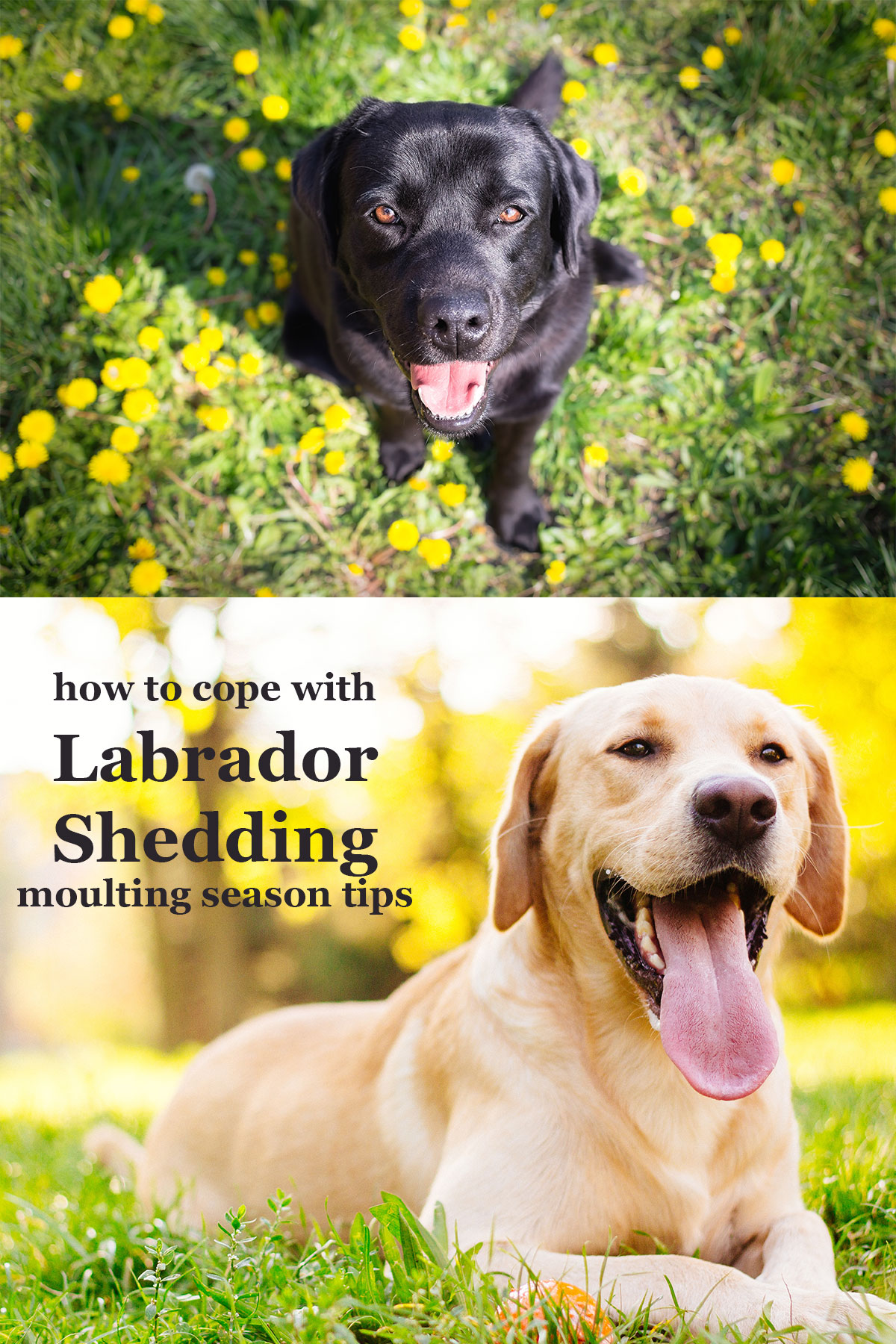
Why does my Labrador shed so much?
When you empty your vacuum cleaner for the tenth time in a day, and wonder if you should dress yourself entirely in yellow to co-ordinate with your yellow Labrador, or fit your house in black carpets to go with your black lab, you may just be asking yourself “why does my Labrador shed so much?” Labrador shedding seems to go on and on.
And while some Labradors are thoughtful enough to shed in a big burst two or even three times a year, many others seem to just shed all year around. This may be connected with the consistent temperature in many modern houses, as dogs that are kennelled often seem to shed in a more seasonal pattern. So why is it, that Labradors shed so much more than some other breeds? The answer lies in your Labradors incredible coat.
A special double coat
Labradors have a neat, short coat, but it is particularly dense compared with many breeds and that is because the Labrador has what we call a ‘double coat’. Underneath that glossy waterproof outer layer, is a dense warm undercoat designed to keep your dog snug while swimming in icy water.
This is great for your dog, and partly explains his enthusiasm for swimming at any time of year. He simply doesn’t feel the cold. It isn’t however, so great for your furniture, your clothes, or your vacuum cleaner. So let’s take a look now at ways we can help get on top of this problem
Differences Between Coat Colors
People sometimes ask me if a Labrador of one color sheds more than a Labrador of another color. Yellow more than black, black more than chocolate, and so on. The answer is, that to my knowledge, no-one has actually measured the quantity of hair that comes off different dogs, so we don’t have a definitive answer for you. It is probable that some Labradors shed more than others. After all, they are all individuals. But whether or not this is linked to color I cannot say.
From a personal point of view, I have had Labs of all three colors and noticed no real difference. Sometimes one color shows up more in the home than another. It probably depends on what color your carpets are. But essentially black labradors shed, chocolate labradors shed, and yellow Labradors shed too. You can’t avoid it by buying a Labrador of a different color. It is probably worth pointing out at this point, that we need to deal with Labrador shedding in the same way, no matter what color your Labrador is. Let’s give you some practical tips.
Home Comforts and Hairy Problems
Our bodies, and the bodies of our dogs, evolve beneficial biological systems over thousands of years. It is only recently we have been protected from the seasons with the luxury of air conditioning and central heating. This is a very short period of time in evolutionary terms
Evolving new biological systems takes a long time. So dogs still continue to shed because it benefitted their recent ancestors. When home comforts have been around for ten thousand years, maybe dogs won’t shed any more. But I’m pretty sure you don’t want to wait that long to get to grips with your hairy problem! Especially when you consider that Labradors shed even more than many other breeds of dog.
How to Cope with Labrador Shedding
I should first say that at the time of writing, there is no pill or potion that you can give your Lab to stop him shedding. The shedding process is entirely natural and normal, if annoying, and there is probably nothing you can or should do, to interfere with it. What you can do however is reduce the impact of a Labrador shedding on your life and home! The two key strategies are:
- Grooming
- Vacuuming
Removing hair from your Labrador
People often think of Labs as being dogs that don’t need much grooming. And when they are not shedding, this is true. However, whenever your Labrador is losing his coat, daily or twice daily grooming is your friend. It will, I promise you, make a massive difference to the quantity of hair in your house.
We’re not talking about ordinary grooming with a bristle brush. We are talking about a serious dead hair removal process. It’s going to make your arms ache, but it will be worth it. There are a couple of grooming tools you might like to consider for this purpose. One is the zoom groom
The zoom groom
This funny looking contraption(paid link)* is a very effective way of removing dead undercoat. Work from head to tail in firm strokes and watch the mounds of hair gather on the floor.

The zoom groom works well for all Labradors, but it can leave a bit of hair behind. For some of my dogs I use a somewhat more controversial tool to prevent my house turning into ‘hair city’. And that tool is a Furminator.
The Furminator
Whether or not this tool suits your dog may depend on his or her individual coat. Labradors really do vary in the way that they moult, and in the thickness of their coats Four year old Tess, pictured here, grows her new coat in, as the old one moults out. Sensible grooming with a Furminator has never revealed bare skin, or done any apparent damage to her coat. All that is stripped out, is soft, dead undercoat. Heaps and heaps and heaps of it. And not only does she feel better for it, so do my carpets.

This is the Furminator(paid link)* I use, and I love it. Bear in mind that some people don’t like this extraordinary grooming device and believe that it damages the coat. And for some dogs, it is not ideal.
Tess’s elderly chocolate friend for example, moults a lot of her old coat out before she grows much of a new one. Using any kind of de-shedding equipment on her can leave bald patches and a furminator would probably be too ‘aggressive’ a tool. I don’t think this is necessarily related to coat color, rather to the individual dog, and possibly to age.
Use your furminator carefully
Furminators seem to be a bit like marmite. You either love them or hate them. And I love them. They make a huge difference to my dogs and to my house. Remember to use with caution. This is a powerful tool. Don’t just keep raking wildly, do a little at a time, and check to make sure you are not leaving bare patches or making the coat too thin.
Can I shave my Labrador?
Just a quick word about shaving: DON’T. People do occasionally ask me if its OK to shave their Labrador. And it isn’t. I appreciate that all that hair can be a problem, but please don’t shave your dog. He could end up with sunburn, he will be unable to control his temperature efficiently, and will be very vulnerable to cuts and injury.
Removing dog hair from your home
Once you are done removing hair from your dog, you’ll want to remove the hair from your house. We’ve had quite a few discussions on this website, about the best vacuums for removing dog hair. Like many of you I love my handheld Dyson(paid link)*, it does a brilliant job of sucking dog hair off carpets and furniture, and I like the ‘bagless’ technology.

You’ll notice that hair drifts around the house, even into the parts that your dog is barred from.
Do robot vacuum cleaners pick up dog hair?
My dogs are not allowed upstairs, but doesn’t stop the hair getting up there! So I have a robot vacuum cleaner that just potters around for an hour each morning.

My elderly robot vacuum cleaner eventually died and I replaced it with a newer model. I love my Neato Botvac(paid link)* so much I now have a second machine so both upstairs and downstairs get a good clean each morning. It has a bigger dustpan than the old one and does a really good job.
If you give the floor a good vacuuming with your standard cleaner before you use your robot for the first time, then set the robot to do its job every day, you’ll find there is room to spare in the dustbox. The battery in mine lasts about an hour and a half which is plenty long enough and I charge it up daily.
Affiliate link disclosure: Links in this article marked with an * are affiliate links, and we may receive a small commission if you purchase these products. However, we selected them for inclusion independently, and all of the views expressed in this article are our own.
The Labrador Site Founder
Pippa Mattinson is the best selling author of The Happy Puppy Handbook, the Labrador Handbook, Choosing The Perfect Puppy, and Total Recall.
She is also the founder of the Gundog Trust and the Dogsnet Online Training Program
Pippa's online training courses were launched in 2019 and you can find the latest course dates on the Dogsnet website

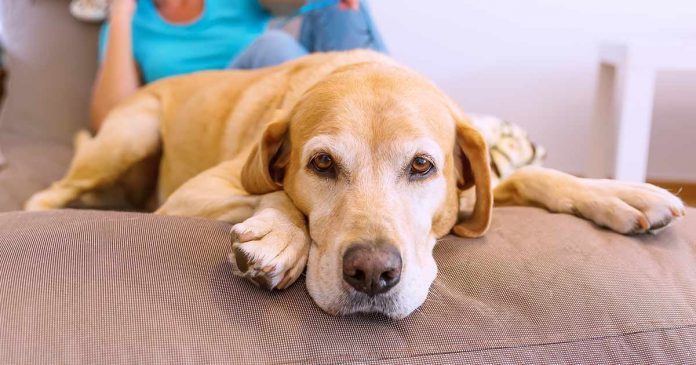
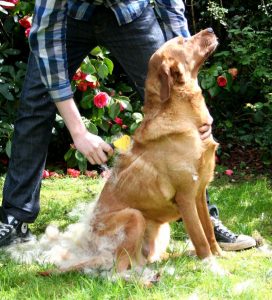
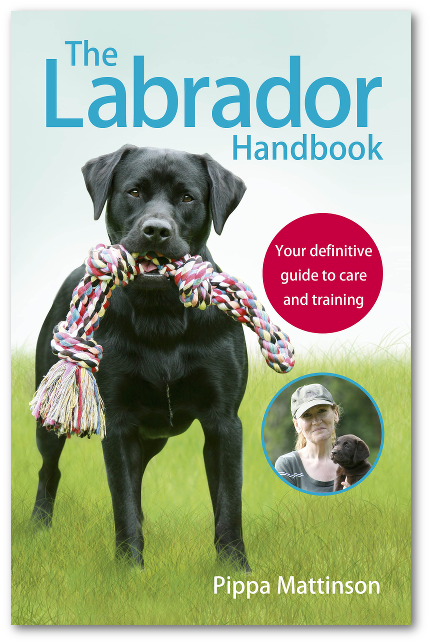






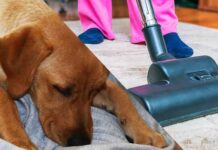









Is their any connection with my granddaughters Croup and our Labrador casting hair
My dog, Bandit, is, moulting his undercoat at the moment, so I’m using a dog comb followed by a slicker brush every day. However, he seems to have lost his appetite for dog food and kibbles but will eat treats and chicken. Is this normal during moulting?
Our chocolate lab’s shedding is starting to take its toll and I bought a Furminator, however, I haven’t used it on him yet as I’m worried about damaging his undercoat during winter – he swims in rivers and lakes in very cold temperatures. Does anyone know whether it simply takes off the already detached hair or if it could compromise his waterproof undercoat? Xx
I use a brush glove on our Rec, just an ordinary plastic job from Pets at Home. It’s much more effective than a traditional wooden brush. I can’t be bothered with a FURminator.
I have 2 labs, one yellow one red. The red has shorter hairs and neither swims (no water source) but I have used furminators on all of them. They actually get excited when I walk outside with it and jockey for the “do me do me” position to be brushed. The amount of hair removed is massive and I would think if it pulled anything out that was essentially attached they wouldn’t be so excited to have it done. I know that doesn’t really answer directly but if its meant to be removed…..just my logic.
One thing I will say is a larger AND smaller is a good idea to get in smaller areas and use caution on less hairy areas like the legs and bellies. Hope that helps
My labs spend alot of time in cold water retrieving ducks so I understand your concern with damaging the undercoat. However, if you use a light touch with the Furminator and don’t use it when their fur is wet, it shouldn’t be a problem. I’ve used one for years on both my dogs (once a week) and it’s been great at keeping the hair down in the house. Just be careful not to press too hard or too deep.
I just Googled, “how to tell if your Labrador sheds too much” and this page was one of the top hits. I am so thankful for your article and just wanted to say thank you. I will be purchasing the Furminator based off your recommendation. Thank you for the sound insight and advice.
Aw, thank you for the kind words Katie! Good luck getting on top of that coat!
Best wishes,
Sarah
The Labrador Site Team
Labs are not for indoor life. They are outdoors, need to run free. They are FARM dogs. Especially american labs, they get stressed out indoors and no excercised they begin to dig holes, chew furniture, etc. In outdoors they live a stress free life, they never get bored, they shed less, and nobody cares bcause the hair goes to the open air!
My lab sheds a lot of her belly fur in summer, leaving he rib cage with only a very thin coat. Is this normal? She has allergies, which aggravate the shedding. I give her coat supplements that give her coat a nice shine, and her fur grows back after the fall freeze, and has a normal thick winter coat. I’m wondering if anyone else has noted really thin hair coat on rib cage/belly. Thanks!
My dog shelby’s coat gets really thin around her ribcage as well. Thanks for posting thought she was the only one.
I vacuum my black Lab once or twice a day during the moulting season. The results are quite remarkable … BB absolutely loves it (I use a small adaptor on the hand held tube) and the amount of hair in my place is almost zero.
Hi Peter, what make/model vacuum do you use on your Lab? Thanks
It would be great if you could share the info about the vacuum attachment!
Hi Guys,
I am first time owner, however I am afraid that if I can handle a dog properly or not.
Can anyone help me with health issues lab has, I tried to google it and ended up with many major issues like obesity and many more related.
as I am a first time owner, m not experienced in this. can some one in here tell me the health status of these dogs.
You can find lots of information on Labrador health problems and prevention here: https://www.thelabradorsite.com/labrador-health/ The main things to look out for when buying a puppy are that the parents have good hip and elbow scores, a recent eye test and are PRA clear.
Hi Judi, I am in Australia and I am looking for the Oates dustpan brush with Silicone bristles and I can’t find it. Are they rubber bristles? Is it the Oates dustpan they sell in Bunnings with rubber bristles?
Don’t care what you say about shaving them down…..all 3 of our yellow girls get bathed and shaved every 8 weeks…..all year round. They look amazing and our house is almost hair free…..you can’t get sunburned laying on the couch
Do you have pictures of them shaved down? I would just like to see how they look.
I use carding knives on all my dogs to remove the dead under coat.
Ok so Labs shed A LOT but what about shedding clumps of hair? My 8 year old black Lab sheds A LOT but has recently started shedding clumps of hair as well. I’ve taken him to the vet and he’s been tested for everything from mites to hypothyroidism. All results come back negative. He has been on a thyroid medicine as well because the vet suspects he is a hypothyroid dog even though the test was negative. I’ve tried changing foods and have been using grain free, limited ingredient foods. I give him 2 good Omega 3 oil tables 3 times a day. I brush him with a furminator until we’re both tired. Nothing seems to help! I do get frustrated with the amount of hair he sheds in the house and sweep at least once a day. I’m concerned there is something wrong with him. Any suggestions?
All labs are different. My black and chocolate dropped clumps from gbeif tear ends and tails. My yellow just sheds singles but his coat is much shorter. I think it depends on coat length and the severity of the seasons. We are in Minnesota. Temps go from high 80’s to -40+ degrees.
I need help I have a black lab puppy he sheds so much he clogs the drain every time he haves a bath and I use a clog cleaner everytime he has a bath.Is that bad for him.
Hi, I have 6 year old Lab named Nika.. last year for the first time we were facing a shedding problem. Vet said its a simple allergy and gave her a shot of ‘urbazon’ but I’m not sure if it was the right call. She appears unable to fully loose her winter coat along her spine, and she’s itchy all the time, only along the spine. I brush her quite often but it doesn’t help. If anyone has any tips or has ever heard about such problem I would be grateful to read it.
Sofija,
Have you tried using a Furmanator brush? I’ve had my Yellow Lab for 10 years now and can definitely say that this brush does a wonderful job. It helps with the shedding as well.
I give my lab Coco fish oil pills. It seems to help with the dry skin & itching. I get a big bottle at Walmart, they’re inexpensive. My girl thinks it’s a treat !
Our lab spends a great deal of time outside with my husband so hair shedding hasn’t been a noticeable problem although he reluctantly submits to being brushed a few times a week. He has just turned a year old and is black with white paw flashes and apparently in excellent health. But he seems to be turning reddish brown over his back and hind quarters whereas he was jet black (apart from his paws). Is this just a normal part of seasonal moulting?
You mentioned that your dog spends a lot of time outside! Well we have a 2 year old black lab who does the same thing my opinion on this is the good old ☀️ it changes the color on my dog just like by the end of summer my hair color is a whole lot lighter. Hopefully this sheds some light on the situation lol good luck with your new puppy!!!
Love the furminator for our constantly shedding Wilbur (yellow) and Lucy (black). I do have a few tools that I love for my furniture. First I have a giant size lint roller. About the size of a paint roller. That helps. Second I have 2 tools that I got at Duluth trading (probably can find elsewhere). One is similar to a pumice stone. You just glide it over fabric and it picks up a lot of hair. In addition, I found a furniture brush there that I use in conjunction with the stone. Worth looking in to. The hair can really get overwhelming. Sometimes I find it hysterical, like tumbleweeds, other times not so much. Still, having owned lots of other dog breeds, I wouldn’t trade these two clowns for anything.
Thanks Carolyn – the lint roller sounds like an excellent idea!
Hi Pippa! I have a 8 month old yellow lab. He is shedding so much! Do you know any ways to cut back the shedding?
When my Lab died in 1988 I couldn’t bear to have another as the heart break was unbearable. My wife badgered me for years until I finally caved in in 2012 and we got a fantastic male Yellow Lab from a local rescue centre. We were aware of the shedding issue but even so it came as a shock just how much this huge guy could produce. Even with using a Furminator we can fill a Miele vacuum bag in one day. However, I discovered a great way of getting his hair off the back the estate car we use. It’s one of those window cleaner’s blades – a squeegie – I think it’s called. It’s on a long pole that reaches into the car with the back seats down. Simply use it on the carpetted areas like a rake. Out comes the hair in great clumps all rolled together. Easy.
I use a horse curry shedder to remove the loose hair from my labs. They will stand still and be groomed for as long as I continue to comb them.
Which length Furminator has everybody found works best with Labs – the short or long hair one? I was thinking short hair, but have noticed some seem to be using the long hair one?
Thanks!
Hi Simon, We use the short hair Furminator for our Labs. Best wishes, Lucy.
I’ve read on various sites that olive oil or fish oil can help reduce year-round shedding. Can anybody confirm that there is a scientific reason for this, or whether it’s just another old folk remedy.
We use ahiflower for our beloved black lab. It’s a completely natural plant based omega 3,6, 9 oil. Great for his coat but also his joints and heart.
BW,
Joanna.
I have 2 labs,one black n one fawn whom i adore. My lab lab sheds soooooo much hair that sweeping the house twice is not enough. Brushing her is do e but… i could easily make 2 stuffed toys every week.:-):-)sometimes dont kno what to do.we stay in a city where it is hot Chennai India
Hi! I have a 9month old lab mix puppy who lost her winter coat around April. She is now shedding like crazy again…is this normal? I wasn’t expecting it until fall.
I have a yellow lab called Lola she seems to moult most of the time, like this article says getting yourself and your dog into a good routine of brushing and hoovering regularly really helps!! I have a dyson Hoover which does a good job of getting all the hair, when I first got Lola I never thought I’d cope with the extra tasks which seemed relentless. Now I Hoover daily and make sure I use the Furminator on Lola which works brilliantly, every 6 weeks I take her to the groomers who give her a really good de shedding and I keep on top of it for the rest of the time. With all this effort I put in you would think hair would be a thing of the past… Well it’s not I now expect to find hair on my clothes, bed, in my car and amywhere else for that matter. I just remind myself on a regular basis how much I love her and each time I Hoover I just have to look at herand then I think I don’t care about her moulting just knowing she’s my lil pup and is happy, healthy and loving life, I don’t care, I’d rather have her in my life with hair everywhere than have a hair free home but no Lola!! It really is a thing you just have to learn to live with !!! #lovinlabradors xxxx
It makes me sad to hear your dog’s are not allowed upstairs. Dogs are family and should be allowed to go anywhere they want
Well if I apply the ‘anywhere they want’ rule, I’m pretty sure my dogs will vote to spend most of the day in my fridge, so I think I’ll give that one a miss 🙂 🙂
😂😂😂
I have 2 labs, one yellow and one black. Both shed differently. Brushing regularly and even bathing helps keep shedding down, but I have also found a supplement that has helped too. I bought Lipiderm from Amazon to help with my lab’s skin after she had had a skin allergy. A side effect was also that it helped lessen shedding and it did! I noticed a huge difference in about 4 weeks of using it. Also people don’t like to say this, but a high quality food diet helps too. My dogs both are fed Taste of the Wild dog food and I don’t feed them any junk at all! I hope this helps!!!
When using a fulminator, how often should one use it on their dog? Daily, every other day, or once a week? I could use it all day on my lab ( I haven’t actually done this) the hair will just keep coming with her coat not getting any thinner!
We have a black and a fox red yellow. I use the furminator, hose them down in the summer weekly and towel dry some. That removes a lot of hair, but there is still copious amounts. Both of mine like to be vacuuned!
my labrador sheds a lot and i have tried everything to control or reduce hair fall but no use.please help me
How to get rid of ticks from my lab
The best vaccum for sucking up all my labs black hair is the Shark Rocket. WAY cheaper than a Dyson, lightweight and best part? It comes apart so when doing stairs, you don’t snap the base to the top handle section and you have a nice compact but still powerful vaccum to get those stairs clean.
Lately, I have dog smell in my house. I have never had this smell before. I have washed the carpets and the lab. I have had her anal glands cleared and I still fight the smell. What is happening?
clean your air ducts. the hair gets in them and smells every time the heat comes on…
Hi! Pippa,my six months old Labrador eats his own poop sometimes.please suggest how to stop him.
Here you go Jay https://www.thelabradorsite.com/why-dogs-eat-poop-and-what-you-can-do-about-it/
try giving your dog some pineapple it works a treat for our two, one of whom just loves poo!
we have a nice black lab great with every one kids other dogs beau is a sweet heart .I found that combing with a curry comb and then using a laytex glove for doing house work works great comb to lossen pet him with the glove repeat . the glove really grabes on to the lose hair and helps to reduce the amount of brushing and is more relaxing for him and me just using the brush for ten min he would want to become a black smith dog and make a bolt for the door lol
What is the best dog food for labs?
Here you go Jill: https://www.thelabradorsite.com/how-to-feed-a-labrador/
I use a zoom groom for my lab doing small circles at a time , she loves it .
I think they find it soothing 🙂
I’ve been using the furminator for years and it is fantastic. I bgt it at a petco after watching a video they had running. The guy was getting tons of hair off of his short haired dog. There was a 30 return policy (or 60, not sure) so I bgt it not really believing it was possible. Oh yeah, I went home and started brushing and got a couple of grocery bags of hair the first time. My lab is 10 yeras old, after he’s brushed his fur shines. It works great and the dog loves it. Well worth the money. I think I paid twice what they are now asking and it was still a great price.
I have two dysons. One is for the house and one I use directly on my blonde lab Paddy. I Hoover him direct and he loves it. However if anyone has any tips on removing hair from my car that would be fab.
Don’t know where you are, Katie, but in Australia we have an Oates dustpan brush with silicone (rubbery) bristles. Works a treat, removing ALL hair from my boy’s trip home from the beach – even when I’ve been slack and left it ages to build up from heaps of trips. Vacuuming did nothing, the brush was a 10 minute job. Spotless!. Comes in a broom to, which is great in the house (any surface – I do the carpet, rug and mats) – saves dragging out the vacuum cleaner all the time. Cheap and super effective.
Sorry no tips on car hair removal. Just wanted to say your comment about vacuuming your dog made me smile. I also vacuum my lab (black lab) directly. While most dogs have so fear of vacuums, mine follows me around whenever I turn it on, begging me to use it on him. He particularly likes when I vacuum his belly with a brush / hose attachment. My favorite is when I vacuum the top of his head and the skin / fur gets kind of pulled up and back.
Get a soft enclosed kennel that is collapsible and can fit into your vehicle. They zip and all hair is then contained to the kennel space and not your car!
I have just ordered one of these will I be ok for my long haired moulting golden retriever?
Hi
Can you tell me the difference between a Furminator, a Rake and a Comb ?
To me all look like a comb.
Kindly help.
Regards
As a first time Labrador Mum, the furminator was recomended to me and boy what a difference it has made!!! Sadie loves her groom time and I find using the furminator followed by the Kong Zoom Groom really does the trick with very few hairs in the house between vaccums; and Sadie has a fantastic glossy coat too!! Mind you I love marmite too!!
I have 2 lovely labs a black and a Goldie, and an other half with a hair allergy :s
The furminator is an awesome tool for reducing the amount of hair in the house and has never caused any harm to the coat of either of my dogs. However it only really works on my black dog it removes his dead undercoat beautifully. The Goldie on the other hand her hairs seem to wrap around the teeth and it doesn’t remove her coat well at all. Have to resort to rubber curry comb for that one.
Love mine! Have to go easy with it on Barney – he doesn’t have much of an undercoat since being a house dog but he really enjoys being groomed and will nudge me for more if I stop. Invaluable with Rusty – although his hair is fine there is a lot more undercoat and this stops handfuls reaching my carpets/trousers etc.
Also use one to get a really astonishing amount of loose hair from a Clumber although with him a pair of scissors also comes in handy!